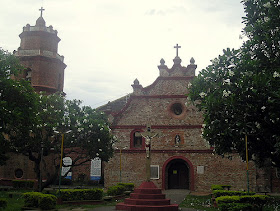The Spanish-era church of D ingras Philippines

Enticed by his cousin Miguel, Lakay Burik decided to migrate to Nueva Vizcaya at around the first decade of the 1900s and settled in a place called Piddigan (later renamed La Torre in honor of the Spanish Governor Ramos de la Torre). Piddigan or La Torre is part of Bayombong that was established as a pueblo in 1739 by the Augustinians. It was, however, a Dominican --- Fr. Juan Crespo --- who started building the present church in 1773 that now serves as the diocesian cathedral and dedicated to

Piddigan was so called because its first settlers were from Piddig, Ilocos Norte. According to family historians from my mother’s side, Miguel Castrovierde Tomas and his brothers killed the cruel Spanish priest of Piddig by stabbing him with a puyod. They then fled to Nueva Vizcaya, founded the barrio of Piddigan, and changed their names into Castros, Vierdes/Verdes, and Tomases. Miguel and his brothers became the Tomas branch. When the Americans invaded, they went back to Piddig to fetch their relatives to join them in Piddigan. That is how their first cousin Lakay Burik joined them.
I visited the church of Piddig 17 June 2005 . In Dingras, I tried to commune with the spirits of my ancestors. In Piddig, I lighted a candle to hail the bravery of Miguel and his brothers and ask forgiveness for their deed. There are no records on when and who built the church but it is believed to be one of the earliest churches in the province of Ilocos Norte

Miguel did not stay long in Piddigan. At around 1906, he and some settlers relocated in a place near Bantay Sabon --- a forested area they passed along the dacquel nga carayan on their way to Piddigan where pure water bubbles from a spring that feeds into a creek with eels as big as a man’s leg. Lakay Burik again joined his cousin in this place where he cleared his dappat and raised his family. It is called Almaguer.


Miguel did not stay long in Piddigan. At around 1906, he and some settlers relocated in a place near Bantay Sabon --- a forested area they passed along the dacquel nga carayan on their way to Piddigan where pure water bubbles from a spring that feeds into a creek with eels as big as a man’s leg. Lakay Burik again joined his cousin in this place where he cleared his dappat and raised his family. It is called Almaguer.

i really appreciate your work.. good thing i opened your flickr accnt, i found many interesting places about my report.. thanks anyway.
ReplyDeleteI am from Piddig, Ilocos Norte and a member of the Tomas family. Your site is very informative. Your story about the Tomases who killed their parish priest and fled to Vizcaya is new to me.
ReplyDeleteMy maternal side is from Dingras, Ilocos Norte. The last name is Flordeliza.I was born there. My family had a house at barangay Guerrero. My family(50 years ago) moved to Mondragon, NOrthern Samar, hometown of my late father. Whereas, I now live with my own family here in Anchorage, Alaska since 1986. My search for a means to establish contact from amongst my relatives led me to your site. It is a thrill to see a picture of the church and to know the details that you gave. My friends and I, as kids, played and climbed the passage way within the walls of the church that goes up to the altar.Did not appreciate then the historical value of this site. Thank you for your posting. Sure brings back memories.
ReplyDeletegusto q n uling bumalik jan s piddig and visit tita anna...thank you for accomodating us.....love the place
ReplyDelete